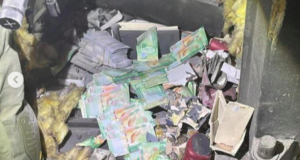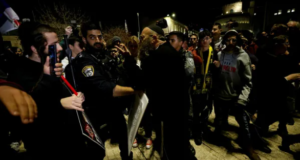Mairav Zonszein, Antony Loewenstein & Joseph Dana | Mondoweiss
18 July 2009
The occupation can seem predictably mundane from a distance. To most Israelis the settlement project is seen as a problem, but a problem happening “over there” and utterly removed from their lives. Rampaging settlers are viewed occasionally on television. Violent Palestinians are seen to resist for no apparent reason. The international community and Barack Obama are protesting the illegal outposts and ongoing colonial project in the West Bank with polls suggesting that many Israelis are opposed to this apparently unfair pressure.
They should spend a day in the West Bank.
For the last three months, Israeli Ta’ayush activists have been accompanying Palestinian farmers from Safa to their lands just below the settlement of Bat Ayin. Since a child from the settlement was murdered in April, settlers have been consistently attacking Palestinians when they attempt to work in their fields, as well as burning the fields themselves – all under the nose of the IDF, which has done nothing to prevent the crimes or punish them.
The scenes from Safa in this period have been grim. If it is not the settlers aggressively driving out the local farmers, it is the army, which acts in complete disregard of Israeli Supreme Court rulings. After weeks of confrontations and brutal arrests, the army seemed to realize that we would not go away, and they would have to change their tactics.
Two weeks ago the army issued a 45-day closed military zone order on the agricultural land of Safa for all Israelis and internationals, asserting that our services would not be needed any longer, as they would ensure the Palestinians could work their land with the army’s protection. In these two weeks, Ta’ayush decided to respect the order and see if the army would indeed deliver on what it promised. However, during this time, the settlers infiltrated the agricultural land of Safa and cut down fruit trees and burned crop fields. Thus, despite the area being a closed military zone for all Israelis, somehow the settlers managed to get past the IDF and commit crimes.
This morning we went back to Safa. As Palestinian Ta’ayush activist Issa Slevi told us later, “The soldiers are settlers but in uniform. They both symbolize the occupation.”
After a local family gave us a sugary glass of tea under a blackberry tree, a large group of Ta’ayush activists and internationals from the International Solidarity Movement and Palestine Solidarity Project walked through the village of Safa towards the fields. The town itself is dusty, with some homes half-finished while other structures have circular staircases on the outside. “I Love Hamas” was sprayed in English on a wall. Children pointed and waved while the women stood together and smiled. Some men led the procession of around 50 people, including the Palestinians. Accredited journalists, from Reuters and Lebanese media, followed. One even held a gas mask, expecting tear-gas.
It was Saturday and the settlers on the nearby hill were virtually invisible. Their houses and caravans sat illegally nearby. A number of IDF soldiers soon appeared on a horizon and approached from the other end of the dirt track. A confrontation was inevitable. The aim was to accompany the Palestinian farmers to their land in the gorge to protect against settler attacks. In the past, activists were physically assaulted and beaten with batons by the IDF so we expected the worst. We didn’t predict two hours of heated debate and political discussion.
The soldiers announced that the Palestinians were allowed to pass on their own and tend their fields. The farmers were highly skeptical because settlers would likely attack them. Some activists pushed the IDF to join the Palestinians but they were denied access. Minor scuffles ensued. Supreme Court orders were produced to explain a 2006 ruling that refused the military being able to impose a “closed military zone” to prevent Palestinians working their fields. The IDF regularly breaks the law of its own country, let alone international law. Activists see it every week.
Unlike previous encounters, the IDF commander seemed like a reasonable man, urging restraint from his men and trying to avoid contact. It was a fruitless task, as the soldiers seemed incapable or unwilling to understand the Palestinian hesitance to farm on their own. One old Palestinian farmer, the owner of the area, arrived. He rode down the path on a donkey, alighted, and walked with a stick. He was highly agitated and screamed at the soldiers. He lifted his shirt after a while to show bruise marks caused by settlers.
Eventually Palestinians decided to pass, both men and women, while a number of activists sat down in front of the soldiers. Others milled around. Video cameras and cameras were in abundance, possible explaining the less aggressive approach of the soldiers. This didn’t stop them from arresting 10 people, who were all detained briefly and released soon after. The activists – who did not resist arrest – knew that if brought before a judge, the army would have been found to have acted illegally. This explains why so often the army releases them before it can happen.
The location of the encounter was actually beautiful. A gorge sat at the bottom of a valley, with green fields and olive groves dotting the landscape.
As we waited and sat under a tree to find some shade, an IDF soldier approached us “to talk about the issues.” He was an American Jew around 30 who had made “aliya” to Israel in 1997. He was not a religious fanatic but argued rationally, despite the confused nature of his argument. He initially acknowledged the Palestinians were under occupation then later said the land was “disputed” and had been given by Jordan. He said the IDF was a “humanitarian model” to the world.
We asked if he’d read the recent Breaking the Silence report on alleged atrocities in Gaza. He said he had not but criticized the soldiers for staying anonymous. When challenged about the use of white phosphorous in civilian areas, he replied that it was not illegal to do so. In fact, it is illegal to use the destructive weapon for anything other than flares and certainly not in civilian areas. Countless human rights groups have accused Israel of using the weapon during its war against Gaza in December and January.
The soldier said he saw himself as protecting the settlers, Palestinians and activists, though we reminded him that the IDF usually only protects the settlers and covers their crimes. We agreed that the potential for confrontation between all parties was high. But why remove the peaceful non-violent leftists? The settlers were the most violent party in Safa. Why doesn’t his unit bar them from entering the gorge and allow us to farm with the Palestinians? He dismissed this question outright. Although he didn’t reside in a settlement, he mumbled something defensive when challenged why the Israelis hadn’t prevented the burning of the fields in the last days and weeks.
He seemed a little conflicted about his role in the territories, despite his arrogant air. He defended the killing of civilians – “you know what Colin Powell said during the invasion of Panama? In war, there’s always collateral damage” – but he was open to alternative views. We joked that it would take a while doing drugs in India to get over his conscience after the things he’d seen and done in the West Bank.
It was a strange discussion, though largely friendly and slightly accusatory. A case-study of the soldier would probably reveal a deep-seated need to defend his actions. He constantly talked about “protecting Israeli democracy” though his main job is protecting the settlement project. Palestinians despise their presence, even if violent resistance is relatively uncommon these days.
We disagreed amongst ourselves to the importance of engagement with IDF soldiers. Joseph wasn’t convinced of the necessity, believing the actions of the man spoke far louder than words. Ultimately, he defended the occupation. Antony was more circumspect and wondered if such encounters could contribute to a slow, changing attitude within the soldiers. Joseph argued that things were desperate when even the seemingly decent Israelis were finding ways to defend the situation.
After we left Safa, we briefly visited Issa Slevi’s home in Beit Umar, a long-time believer in non-violent action, in a room with a high ceiling. As we drank hibiscus juice and then piping, hot tea, he told us about the reality of constant IDF harassment of towns and fields. “The media presents the Palestinians as murderers and terrorists and the Israelis as victims”, he said. “The whole world identifies with the Israelis.”
Slevi spoke of a time when his hope for a resolution in the early 1990s had inspired him to distribute flowers to soldiers. But today he was despondent about Fatah – “an Oslo puppet regime” – and damned the “peace process” of the 1990s. It has produced nothing more than settlements and settler violence. He compared the situation in Palestine to the Jim Crow period in the US, “when there were signs that were for ‘dogs only.’ Today, the situation is the same for the Palestinians but there are no signs.”
Despite all the abuse and violence, Slevi was fundamentally opposed to violence. He never spoke to settlers. He wanted a country where both peoples could interact and mingle freely, regardless of religion and political affiliation.
The day was relatively normal in an utterly foreign reality.
 International Solidarity Movement Nonviolence. Justice. Freedom.
International Solidarity Movement Nonviolence. Justice. Freedom.


